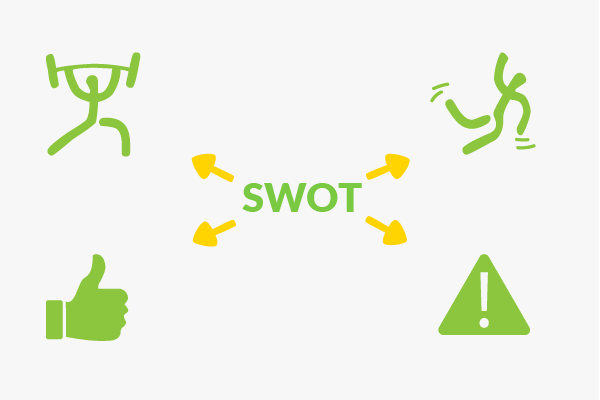SWOT Analysis
The SWOT analysis is an important tool for strategic management. It is based on the analysis of business internal and external factors. It helps for developing strategies and defining budgets and resources. At the same time, strategic planning can help initiate measures in marketing or other areas. SWOT analysis is often also required for the preparation of business plans to finance start-ups, for controlling or capital increase of companies.
Definition
The expression “SWOT“ is an acronym of the words Strengths, Weaknesses, Opportunities and Threats. The SWOT analysis is divided into four areas, whereby the strengths and weaknesses are determined by internal factors and the opportunities and risks by external factors.
Determination of Strength and Weaknesses for the SWOT analysis
In order to identify your own strengths and weaknesses, no direct competitor analysis or environment analysis is required. Rather, it is a self-analysis, which is also called an internal analysis. The focus is on closely observing your own company, system, project or product.
EXAMPLES FOR STRENGTH
Strengths are usually those company characteristics that have a competitive advantage, such as [Unique Selling Point|USPs]], special products or properties. These include, for example, the following aspects that set the company apart from the competition in a positive sense:
- Low fixed costs
- Highly qualified employees
- Cross-Selling as distribution strategy
- Up-Selling as marketing method
- Good (traffic) infrastructure
- Products with high level of innovation
- Extensive technical Know-how
- High loyalty
- High product quality
- Flexible reaction on market changes
- Flat hierarchy and short decision-making routes
To identify the weaknesses, you need to check how previous success has been achieved and how the company contrasts with the competitors.
EXAMPLES FOR WEAKNESSES
Weaknesses are business’characteristics that could turn out as a disadvantage for the competition. Possible examples could be:
- High dependence on a certain supplier or a small customer base
- Bad sales-position
- Low equity base
- High level of prices
- Outdated IT-system
- High turnover rate of personnel
- Low brand awareness
The weaknesses can be figured out while analyzing why orders or customers are lost to the competitors.
Identifying Opportunities and Threats for the SWOT
The second step of the SWOT analysis is to identify factors that can affect the company in a positive as well as in a negative sense, but which can only be influenced to a limited extent or at all. Typical examples are changes in the market, legislative changes or trends. This environmental analysis is also referred to as exogenous factors.
EXAMPLES FOR OPPORTUNITIES
Opportunities are external developments which could be an advantage for the company. Possible examples are the following:
- Trends and developments in the society
- Changes in the consumers’ behavior
- Technological progress
- Filling niches
- High market potential
- New distribution channels
EXAMPLES FOR THREATS
External developments can also be a threat and risk for the company, e.g.:
- Legal changes to the detriment of the company
- Actions in the stock market or with exchange rates
- Market entry of new competitors
- Cheaper competitors (from low-wage countries)
- Price drop because of excess supply
- Low economic activity
Making connections and deriving measures
All identified strengths, weaknesses, opportunities and threats are put together in a SWOT matrix. Connections can be made visible and are noted down. From these connections, possible strategies can be derived to improve one's own market position or to define fields of action. The aim is to use the existing strengths to compensate for weaknesses and to use the opportunities to compensate for the possible risks.
Problems with the SWOT analysis
The SWOT analysis has to face many problems that question its significance:
- Subjectivity: Not only the selection but also the evaluation of the factors do not follow objective standards. There is a high risk that critical factors are kept out and are considered to be weak. In addition, it’s possible to overrate strengths and opportunities in order to prove decisions that have already been made.
- Disregarding the competitors: Though the competitors are taken into consideration in the beginning they could be forgotten for the analysis of opportunities and threats. Yet, it would be very important to react on competitors and changes in the market with your own strategies.
- Missing benchmark: There is no standard for the quantification and evaluation of the four fields and their derived strategies.
- High effort: A SWOT analysis is more meaningful the more data it is based on. To get this data a high research effort is needed.
Significance for Online Marketing
A detailed SWOT analysis can help to avoid potential mistakes, particularly when planning online marketing campaigns for the long term. But especially in a dynamic environment such as online business, all those involved should be aware that their actions and measures need to be regularly readjusted. For example, the guidelines of search engine optimization may have changed since the creation of the strategy planning based on the SWOT analysis. In this case, individual aspects can shift within the matrix of strengths, weaknesses, dangers and opportunities. This means that the model should always be updated when it comes to long-term planning.

